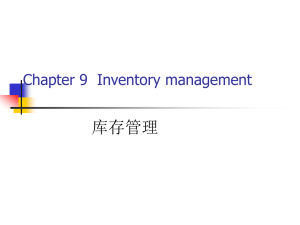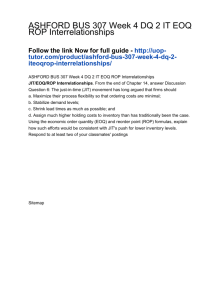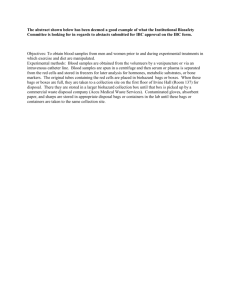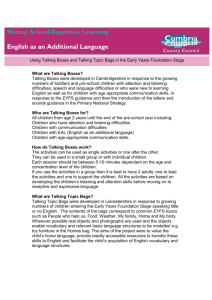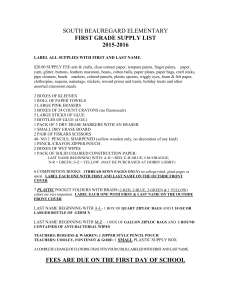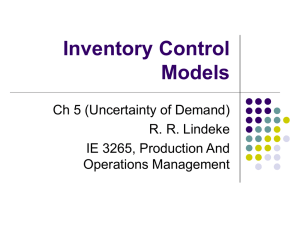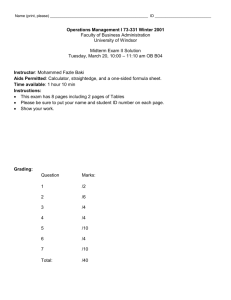HW #10 Inventory Control Continuous versus Periodic
advertisement
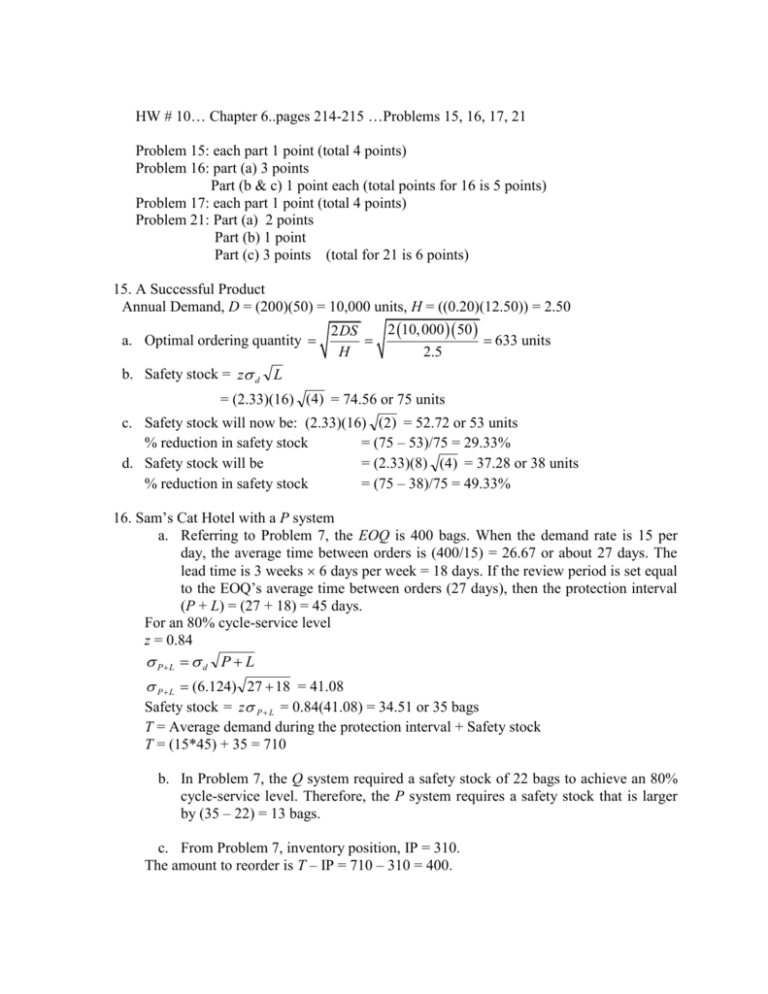
HW # 10… Chapter 6..pages 214-215 …Problems 15, 16, 17, 21 Problem 15: each part 1 point (total 4 points) Problem 16: part (a) 3 points Part (b & c) 1 point each (total points for 16 is 5 points) Problem 17: each part 1 point (total 4 points) Problem 21: Part (a) 2 points Part (b) 1 point Part (c) 3 points (total for 21 is 6 points) 15. A Successful Product Annual Demand, D = (200)(50) = 10,000 units, H = ((0.20)(12.50)) = 2.50 a. Optimal ordering quantity 2 10, 000 50 2 DS 633 units H 2.5 b. Safety stock = z d L = (2.33)(16) 4 = 74.56 or 75 units c. Safety stock will now be: (2.33)(16) 2 = 52.72 or 53 units % reduction in safety stock = (75 – 53)/75 = 29.33% d. Safety stock will be = (2.33)(8) 4 = 37.28 or 38 units % reduction in safety stock = (75 – 38)/75 = 49.33% 16. Sam’s Cat Hotel with a P system a. Referring to Problem 7, the EOQ is 400 bags. When the demand rate is 15 per day, the average time between orders is (400/15) = 26.67 or about 27 days. The lead time is 3 weeks 6 days per week = 18 days. If the review period is set equal to the EOQ’s average time between orders (27 days), then the protection interval (P + L) = (27 + 18) = 45 days. For an 80% cycle-service level z = 0.84 P L d P L P L (6.124) 27 18 = 41.08 Safety stock = z P L = 0.84(41.08) = 34.51 or 35 bags T = Average demand during the protection interval + Safety stock T = (15*45) + 35 = 710 b. In Problem 7, the Q system required a safety stock of 22 bags to achieve an 80% cycle-service level. Therefore, the P system requires a safety stock that is larger by (35 – 22) = 13 bags. c. From Problem 7, inventory position, IP = 310. The amount to reorder is T – IP = 710 – 310 = 400. 17. Continuous review system. a. Economic order quantity. 2 2, 000 40 2 DS 894.4 or 894 units H 2 Time between orders (TBO) = Q/D = 894/20,000 = 0.0447 years = 2.32 weeks EOQ b. Weekly demand = 20,000/52 = 385 units For a 95% cycle-service level, z = 1.65 Safety stock: z d L = (1.65)(100) 2 = 233.34, or 233 units Now solve for R, as R = d L + Safety stock = 385(2) + 233 = 1,003 units c. i. Annual holding cost of cycle inventory Q 894 H 2 $894.00 2 2 1. Annual ordering cost D 20,000 S $40 $894.85 Q 894 d. With the 15-unit withdrawal, IP drops from 1,040 to 1,025 units. Because this level is above the reorder point (1,025 > 1,003), a new order is not placed. 21. Wood County Hospital a. D = (1000 boxes/wk)(52 wk/yr) = 52,000 boxes H = (0.l5)($35/box)=$5.25/box 2 52, 000 $15 2 DS 545.1 or 545 boxes H $5.25 Q D C H S 2 Q 900 52, 000 C900 $5.25 $15.00 $3, 229.16 2 900 545 52, 000 C545 $5.25 $15.00 $2,861.82 2 545 The savings would be $3,229.16 – $2,861.82 = $367.34. EOQ b. When the cycle-service level is 97%, z = 1.88. Therefore, Safety stock = z d L = (1.88)(100) 2 = 1.88(141.42) = 265.87, or 266 boxes R = d L + Safety stock = 1000(2) + 266 = 2,266 boxes c. In a periodic review system, find target inventory T, given: P = 2 weeks L = 2 weeks Safety stock = z P L P L d P L P L (100) 2 2 = 200 units. Safety stock = 1.88(200) = 376 units T = Average demand during the protection interval + Safety stock T = 1000(2 + 2) + 376 T = 4,376 units The table below shows that the total cost for the Q system is much less than that of the P system. The reason is that the optimal value of P was not used here. The optimal value is P 0.55 weeks. Continuous Review (Q) system z= Safety Stock Reorder Point Annual Cost Periodic Review (P) System 1.88 Time Between Reviews (P) 266 Standard Deviation of Demand During Protection Interval 2266 Safety Stock $4,258.32 Average Demand During Protection Interval Target Inventory Level (T) Annual Cost 2.00 Weeks 200 376 4000 4376 $7,614.00

